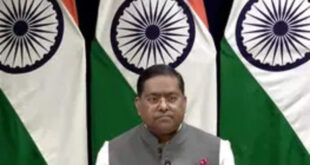[ad_1]

Fasten your seatbelts – With India’s growing status in the world, thanks to its booming economy, a preferred market for investors or its allure as a popular destination for travel enthusiasts world over, the country is truly poised for take-off when it comes to being a destination for international tourists.
As we step into 2024, the spotlight shines bright on the vast potential for tourism in India, thanks to its geographical diversity and myriad cultures, each offering a unique and captivating experience. Between January and September 2023, India experienced an influx of 6.43 million Foreign Tourist Arrivals (FTA.) . Fueled by emerging market trends, it is anticipated that this figure will ascend to pre-pandemic levels by the end of this year, positioning India as an enticing and flourishing market for international travelers.
Delving deeper into these emerging “trends”, it’s evident that consumers are venturing into the realms of the “less traveled”, exploring destinations far removed from the typical landscapes of India’s mainstream cities. Within India, the quest for offbeat destinations, away from metropolitan cities, is driving a notable shift in the inbound tourism segment. Per a recent Visa study during the remarkable ICC Men’s Cricket World Cup 2023 held in India, many visiting international tourists extended their trips to destinations such as Jaipur, Agra, Goa, Varanasi, and Udaipur.
Noteworthy trends are seen in the space of spiritual, medical, business, MICE, sustainable and adventure tourism, each playing a pivotal role in shaping this evolving landscape. A comprehensive report, “Charting the Course for India – Tourism Megatrends Unpacked, jointly conducted by Visa and EY, mentioned that the spiritual tourism segment in India, that has drawn millions of tourists on a journey of yoga, discovery, divinity and philosophy, is poised to attract a staggering 30.5 million international visitors by 2028. Additionally, with Ayodhya experiencing a surge in tourism due to the new Ram Temple, complemented by concerted efforts from the Indian Government to amplify inbound tourism and connectivity, the overall international travel influx into India is primed to reach unprecedented levels.
As tourism continues to evolve in India, travelers’ cross border payment preferences continue to shift. There is an increasing preference for adopting quick and simple payment methods – and the proof is in the TAP! Card based ‘Tap to Pay’, or Phone based ‘Tap to Pay’, where the card is securely and digitally stored on the phone, is seeing unprecedented growth in merchant payments, and more so when it comes to transit. For instance, Transport for London (TFL) sees a sizeable number of transactions from international tourists every year. More and more Metro, City Bus and Ferry operators are adopting this seamless mode of tapping a card to pay for ticketing worldwide, saving commuters millions of hours in queuing every year. As India seeks to attract more and more foreign international travelers, this is one area worth investing in.
While the credit card market in India is experiencing significant growth, merchants will do well to ask their acquiring bank that provides the POS terminal for international payment acceptance, especially if they cater to international tourists. Since sustainable tourism is also a segment taking the centerstage for the international travel community, the quest for traveling to offbeat locations will mean tier 2 and tier 3 regions in the country must also ramp up acceptance of internationally ubiquitous digital payments, to cater to the international customer used to paying with their cards.
India’s strides towards securing its position as the world’s fifth-largest market for travel and tourism persists and with that, comes remains an untapped potential for the country to shine even brighter on the global stage. By placing increased emphasis on critical elements such as security and convenience, user-friendly innovations, comprehensive consumer education, and widespread payment acceptance within the travel and tourism sector, India can maximize its trajectory of tourism. On this National Tourism Day, we must all, as stakeholders, commit to offer consumers tech-enabled innovative solutions, as we do our bit to foster a robust, resilient, and thriving tourism industry in India.
The author is the Business Head, Cross Border Payments, at Visa India and South Asia.
Disclaimer: The views expressed are solely of the author and ETTravelWorld.com does not necessarily subscribe to it. ETTravelWorld.com shall not be responsible for any damage caused to any person/organisation directly or indirectly.
Source link





